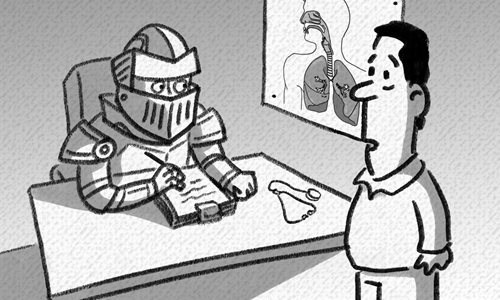Patient outrage in China needs treatment

Illustration: Liu Rui/GT
The recent tragedy in which the son of a patient killed a doctor at the Beijing Civil Aviation General Hospital is shocking but not unprecedented. I talked to two friends, both working in hospitals, one in China and the other in the US. Their different reactions were striking.
According to media reports, the assailant, Sun Wenbin, believed the condition of his 95-year-old mother deteriorated because the doctor, Yang Wen, had allegedly given the wrong drug. He was also upset because the family's plea to transfer his mother from an emergency ward to an inpatient ward, so they could save money under China's public health insurance system, was declined. Sun attacked Yang with a knife while the doctor was working at the emergency ward. The physician was almost beheaded.
The bone-chilling brutality appalled everyone, my friends included. Yet my Chinese friend sounded sad but resigned. She said doctors in China were facing physical threats on a regular basis. She had witnessed her colleagues being attacked by angry patients or their family members. The family of a boy who died in her hospital placed his body on a table in front of the hospital for days until it agreed to compensate them even after the medical inspection report had cleared the doctor of wrongdoing.
My American friend covered her mouth with a hand to muffle a scream when I told her the story. "How could this have happened?" she asked with an expression that mixed incredulity with horror. "In the US, this dispute is most likely to be solved in court," she said.
This doesn't mean American hospitals are completely safe. Because of the stress patients and their family members are under, healthcare is a profession exposed to greater workplace violence risk than many others. According to a poll released by the American College of Emergency Physicians, in 2018 close to half of medical workers who work in emergency rooms in the US said they had been physically assaulted. Fatal attacks are not unheard of. In 2017, a man shot dead a physician who refused to prescribe opioids for his wife's chronic pain and then killed himself. Earlier in 2019, in Louisiana, a nurse died after coming to blows with a patient who went berserk.
When there are such incidents there is inevitably an outcry among physicians calling for better protection. But the prevalence of such cases is far below the level that would make doctors declare that violence is part of their everyday lives.
Tight security contributes to the relatively normal life of American physicians. Unlike in China where hospital security guards are rarely armed with weapons stronger than an electronic baton, 52 percent of American hospitals have guards armed with handguns and 47 percent with Tasers, according to a report in The New York Times in 2014. If anything, those percentages may be higher now. Many hospitals are equipped with metal detectors and require everyone including those on stretchers to pass through them.
But the legal outlet my American friend pointed out can also play a significant role.
Medical malpractice suits are an established part of the US judicial system. Previous surveys show one in three physicians in the US have been sued for malpractice, and a physician is sued every seven years. The average paid claim of such lawsuits has gone up to $348,065 in 2018 from $250,000 in 2014, according to the National Practitioner Data Bank. Just a few days ago, a woman in Louisville who had her leg amputated after the surgeons left a sponge inside her body during heart surgery was awarded $10.5 million by a court.
Sometimes, the patients don't even have time to mourn their loss before medical damage attorneys swarm around them to beg for their business. The lawyers usually work on a contingency basis, taking a percentage of the awards or settlements and waive their fees if the case is lost.
Doctors don't like this. A lawsuit means higher insurance premiums and a tarnished reputation. But the appeal of hefty compensation and the lengthy legal process it takes to pursue it may well cool down the hotheads and avert some violent tragedies.
Creating a more robust legal and complaints system may be the lesson that should be learned from the Beijing tragedy. But the lesson not only applies to healthcare.
In his 2013 movie, A Touch of Sin, Chinese director Jia Zhangke zoomed in on the increasing anger and resentment among ordinary Chinese who feel their chances of upward mobility in society are limited. The problem only grows more palpable today. And the increasing hospital violence is only part of it.
In the US when people feel they are mistreated by public entities, even when a lawsuit isn't an easy option, the ubiquitous independent ombudsman offices or complaint review boards within the likes of hospitals or government agencies can give their concerns a hearing. These are not the most efficient or effective venues to solve a conflict as cases often drag on for years or even decades, but they also offer a non-violent avenue for the aggrieved who may otherwise act violently out of rage.
The American model may not fit in China. But China certainly needs to establish a more functional venting system for itself.
The author is a New York-based journalist and Alicia Patterson fellow. rong_xiaoqing@hotmail.com


